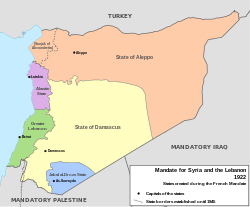State of Alawites
| Alawite State | ||||||||||
|
Alaouites دولة العلويين |
||||||||||
| Mandate of French Colonial Empire | ||||||||||
|
||||||||||
|
The Alawite State (purple) in the Mandate of Syria.
|
||||||||||
| Capital | Latakia | |||||||||
| Languages |
French Arabic |
|||||||||
| Religion | Alawite Shia Islam | |||||||||
| Political structure | League of Nations Mandate | |||||||||
| Historical era | Interwar period | |||||||||
| • | French occupation | 1918 | ||||||||
| • | Established | 2 September 1920 | ||||||||
| • | State declared | 1923 | ||||||||
| • | Named "Government of Latakia" | 1930 | ||||||||
| • | Disestablished | 3 December 1936 | ||||||||
|
||||||||||
| Today part of |
|
|||||||||
The Alawite State (Arabic: دولة جبل العلويين, Dawlat Jabal al-‘Alawiyyīn, French: Alaouites, informally as État des Alaouites or Le territoire des Alaouites) and named after the locally-dominant Alawite Shi'a sect, was a French mandate territory on the coast of present-day Syria after World War I. The French Mandate from the League of Nations lasted from 1920 to 1946.
The use of "Alawite" instead of "Nusayri" was advocated by the French early in the Mandate period, and referred to a member of the Alawi religious sect. In 1920, the French-named "Alawite Territory" was home to a large population of Alawi Muslims.
The region is coastal and mountainous, home to a predominantly-rural, heterogeneous population. During the French Mandate period, the society was divided by religion and geography; the landowning families and 80 percent of the population of the port city of Latakia were Sunni Muslim. More than 90 percent of the province's population was rural, and 82 percent were Alawites.
...
Wikipedia


